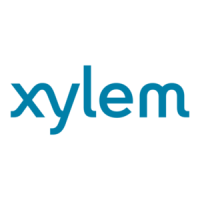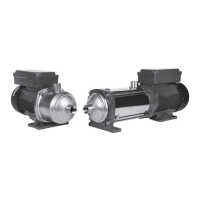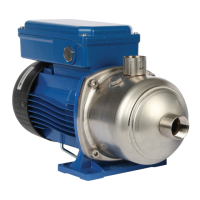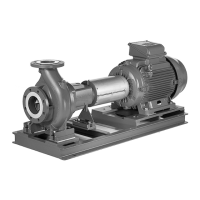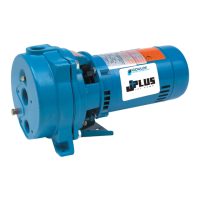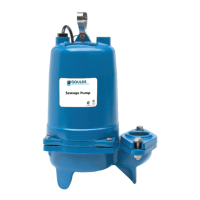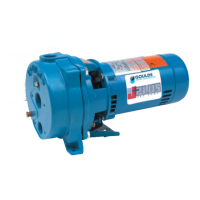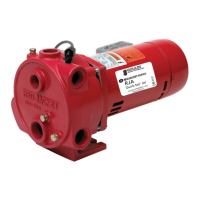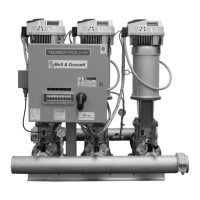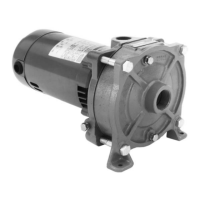
Do you have a question about the Xylem Goulds HSC and is the answer not in the manual?
| Type | Horizontal Split Case |
|---|---|
| Application | Water supply, HVAC, industrial |
| Sizes | 3" to 16" discharge |
| Temperature Range | Up to 250°F (121°C) |
| Materials | Cast iron, bronze fitted, stainless steel |
| Applications | Water Supply, Irrigation, HVAC, Fire Protection |
Inspect unit for damage and report any damage to the carrier/dealer immediately.
Ensure separate branch circuit with proper fuses/breakers and wire sizes per electrical codes. Install disconnect switch.
Wire motors for proper voltage, ensuring wire size limits voltage drop to 10% at motor terminals.
Always use horsepower-rated switches, contactors, and starters.
Use thermal protection for single-phase units or contactor with overload; fusing is permissible.
Specifies liquid temperature, working pressure, and start frequency for the pump.
Regular inspection and maintenance will increase service life. Base schedule on operating time.
Locate pump near liquid source, below level for automatic operation. Protect from freezing/flooding.
Allow adequate space for servicing and ventilation around the pump.
All piping must be supported independently of the pump and 'line-up' naturally.
Avoid unnecessary fittings. Select sizes to minimize friction losses.
Units may be installed horizontally, inclined, or vertically.
Caution: Do not install with motor below pump; leakage/condensation affects motor.
Desired: low static suction lift and short, direct piping. Consult NPSHR curve for lifts above 15'.
Suction pipe must be at least as large as pump connection; smaller size degrades performance.
If larger pipe is needed, install an eccentric pipe reducer (straight side up) at the pump.
Install full-flow isolation valve for inspection/maintenance. Do not use to throttle pump.
Avoid air pockets, keep piping below suction connection, slope upward. Ensure airtight joints.
Foot valve only if necessary for priming. Strainer open area must be triple pipe area.
Inlet size and submergence must prevent air entry via vortexing.
Use 3 to 4 wraps of Teflon tape to seal threaded connections.
Include a check valve between a gate valve and the pump for regulation and inspection.
If an increaser is required, place it between the check valve and the pump.
Use 3 to 4 wraps of Teflon tape to seal threaded connections.
Correct rotation is right-hand (clockwise when viewed from the motor end).
Prime the pump (free of air, suction pipe full) and partially open discharge valve before starting.
Make complete check after unit runs under operating conditions and temperature stabilizes.
Ball bearings are in the motor, permanently lubricated; no greasing is required.
Caution: Running pump dry will seize parts and damage the seal. Do not operate at zero flow.
Disassemble only as far as required for maintenance. Turn off power and drain system.
Remove casing bolts, then motor/liquid-end assembly. Remove impeller bolt and washer.
Remove impeller by pulling axially. Avoid using vanes to prevent damage.
Remove separator plate, shaft sleeve, intermediate stages, and last impeller/plate.
Remove seal retainer, shaft extension, rotating element, and motor adapter.
Clean all parts before assembly. Refer to parts list for replacement items. Reassembly is reverse of disassembly.
Inspect mechanical seal components and o-rings. Replace if damaged. Lubricate o-rings with petroleum jelly.
Inspect impellers for wear/blockage and iron parts for corrosion. Replace as necessary.
Wear rings in interstage(s) and casing may need pressing or prying out and in for replacement.
Tighten casing bolts in a criss-cross manner to 35 ft-lbs to prevent o-ring binding.
Common causes include tripped thermal protector, open breaker, blown fuse, binding parts, or improper wiring.
Causes include not primed, plugged discharge, incorrect rotation, small foot valve, or low voltage.
Likely causes include binding parts, incorrect impeller diameter, high head/flow, or worn bearings.
Causes can be binding parts, worn bearings, loose pump/piping, or misalignment.
Detailed list of pump components with item numbers, part names, and quantities.
Cross-reference of motor horsepower, model codes, and order numbers.
Warranty covers defective parts for 12 months from installation or 18 months from manufacture, whichever is shorter.
Excludes labor, transportation, reinstallation costs, consequential damages, and loss from service interruption.
Defines terms like 'Distributor', 'Dealer', and 'Customer' for warranty purposes.
